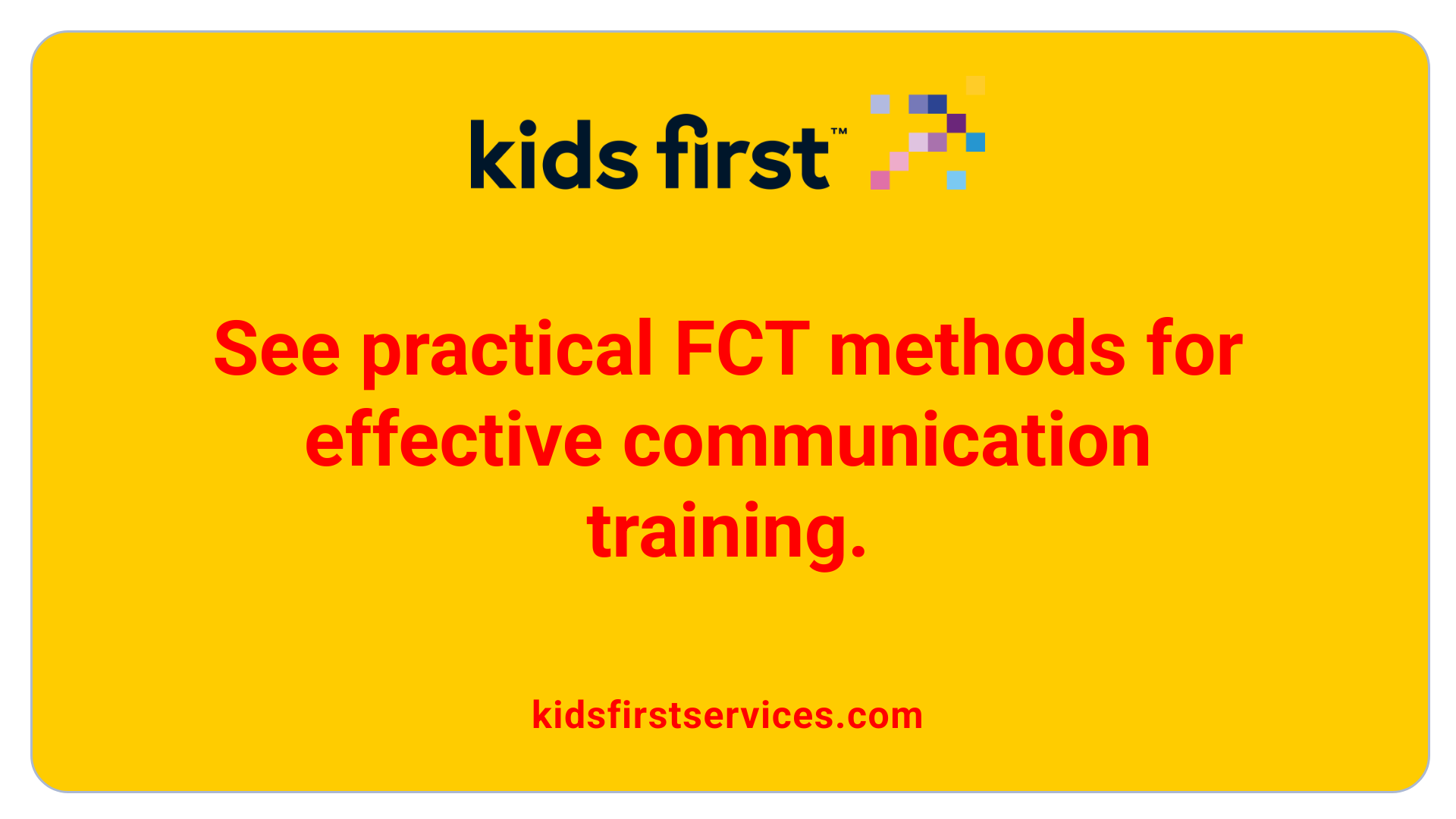
The Importance of Functional Communication Training in ABA Therapy
Unlocking Effective Communication in ABA Therapy: The Power of Functional Communication Training
Exploring FCT in ABA Therapy
Functional Communication Training (FCT) is a cornerstone of Applied Behavior Analysis (ABA) therapy, offering individuals with autism and other developmental disorders a way to replace challenging behaviors with constructive communication. Introduced in the mid-1980s, FCT has revolutionized behavioral interventions by focusing on adaptive communication strategies to meet an individual's needs effectively. This narrative delves into the fundamentals, benefits, and implementation of FCT, highlighting its role in reducing problem behaviors while promoting independence.
Understanding Functional Communication Training (FCT)

What is functional communication training (FCT) in Applied Behavior Analysis (ABA)?
Functional Communication Training (FCT) is a behaviorally-based intervention used in Applied Behavior Analysis (ABA) primarily designed to help individuals with developmental disabilities express their needs and wants more effectively. Developed by Carr and Durand in 1985, FCT employs a differential reinforcement approach, focusing on replacing problematic behaviors with appropriate communication responses that fulfill the same function.
Key components of FCT include:
- Functional Behavior Assessment (FBA): Identifying the reasons behind challenging behaviors.
- Selection of Alternative Responses: Choosing meaningful communication methods suitable for the individual, such as gestures, sign language, or picture communication systems like PECS.
- Teaching and Reinforcement: Systematically teaching new communicative skills and consistently reinforcing successful communication while ignoring maladaptive behaviors.
Research indicates FCT effectively reduces severe behavior problems, like aggression and self-injury, particularly in children diagnosed with autism. Its implementation typically spans various environments, promoting communication skills and enhancing overall life quality for individuals through improved social interactions and emotional expression.
Furthermore, the consistent application of FCT in community settings and collaboration with family members are crucial for sustaining communication success, empowering individuals to communicate their needs confidently and appropriately.
The Crucial Role of Communication in ABA

Why is communication important in ABA therapy?
Communication plays an essential role in Applied Behavior Analysis (ABA) therapy, particularly for children with autism spectrum disorder (ASD). Effective communication can transform a child's experience, impacting their overall well-being.
Impact on ASD
For children with ASD, being able to express their needs and wants is vital. ABA therapy focuses on developing both expressive and receptive language skills. This enables children to articulate their thoughts and comprehend others effectively. As communication skills improve, children can engage more with the world around them, showcasing their preferences and emotions.
Development of language skills
Through targeted interventions, ABA therapy enhances vocabulary, sentence structure, and conversational skills. Children learn to initiate conversations and respond appropriately, which are critical for meaningful interactions.
Non-verbal communication benefits
Non-verbal communication is equally significant. Children learn to interpret body language and facial expressions, crucial elements in social contexts.
In summary, effective communication skills cultivated through ABA therapy foster independence and enhance relationships, paving the way for a more fulfilling life for children with ASD.
Benefits and Applicability of FCT

Reduction of severe behaviors
Functional Communication Training (FCT) stands out for its ability to significantly reduce severe behaviors in children, especially those with Autism Spectrum Disorder (ASD). By teaching them effective communication skills, FCT helps replace challenging behaviors—like aggression or self-injury—with more appropriate responses. This approach not only addresses the behavior but also tackles the frustration stemming from communication difficulties.
Applicability for various disabilities
FCT is not limited to children with ASD; it has proven effective for individuals across a range of developmental disabilities. Its structured and adaptable nature makes it suitable for nonverbal learners and those with limited communication skills, utilizing methods such as sign language, picture communication systems (PECS), and gestures. This versatility enables professionals to tailor interventions according to the specific needs of each child.
Generalization of skills
One of the strengths of FCT is its focus on generalizing communication skills across various settings and caregivers. As children learn alternative communication methods, they practice these skills in different environments, ensuring consistency and reinforcing their learning. This generalization ultimately helps children feel empowered in expressing their needs in various contexts.
Empowerment through communication
FCT empowers children by enhancing their ability to communicate effectively. This increased capability leads to greater independence and improved social interactions. As children learn to articulate their needs, feelings, and choices, they experience a boost in self-advocacy, thereby enhancing their overall quality of life and emotional well-being.
| Aspect | Details | Impact |
|---|---|---|
| Reduction of behaviors | Replaces challenging behaviors with communication | Decreases frustration |
| Applicability | Effective for various disabilities, adaptable methods | Tailored interventions |
| Generalization of skills | Skills practiced across settings and caregivers | Increases communication success |
| Empowerment through communication | Enhances independence and social interactions | Improves quality of life |
Practical Examples of FCT Methods

What are the common examples of Functional Communication Training (FCT) in ABA?
Functional Communication Training (FCT) employs various methods to help children communicate their needs effectively, thereby reducing challenging behaviors. These methods include:
Use of Gestures and Signs: Children can be taught to use simple gestures or signs as a means of communication. For example, a child might learn to raise their hand to indicate they need assistance, or use a sign for specific needs, like hunger or tiredness, instead of engaging in disruptive behaviors.
Role of Augmentative and Alternative Communication (AAC): AAC systems, such as speech-generating devices or communication apps, provide visual cues that support verbal communication. For instance, a nonverbal child might use a tablet with an AAC app to select images representing their wants or needs.
Picture Communication Systems: Tools like Picture Exchange Communication System (PECS) enable children to communicate by exchanging pictures. If a child wants a snack, they can hand over a picture of the snack instead of experiencing frustration from being unable to articulate their desire verbally.
Non-Verbal Communication Methods: Techniques like using body language, facial expressions, or other non-verbal cues are also vital. A child might learn to point to items they want to avoid the need for vocalizing, creating smoother interactions.
These strategies are practical examples that not only help to minimize challenging behaviors but also allow children to express themselves in ways that feel accessible to them. By focusing on methods that cater to their abilities, the overall aim is to improve both communication skills and the quality of life for these children.
Implementing Functional Communication Training

What are the steps involved in implementing functional communication training?
The implementation of Functional Communication Training (FCT) follows a systematic, five-step process. It begins with identifying the challenging behavior and defining it in clear, observable terms. This clarity is essential as it helps focus interventions on the specific actions that need to be modified.
Next, a Functional Behavior Assessment (FBA) is conducted to determine the function of the behavior. This assessment analyzes the antecedents (triggers) and consequences that reinforce the undesirable behavior using ABC data.
Once the analysis is complete, the third step involves selecting an appropriate communication method or replacement behavior. This should be communication that the individual can use easily to express their needs, such as gestures, sign language, or pictures.
Teaching the new communication skill comes next. This should occur in natural contexts where the individual can practice and apply their new skills. Reinforcement of the new behavior is crucial, while gradually decreasing the reinforcement for the problem behavior to encourage a transition to the more desirable communication.
Finally, continuous monitoring of progress through data collection is vital. Tracking both the problematic and replacement behaviors helps determine the effectiveness of the intervention. Adjustments can then be made as necessary, ensuring that the approach remains tailored to the individual's evolving needs.
Addressing Problem Behavior with FCT
How does functional communication training address problem behavior?
Functional communication training (FCT) addresses problem behavior by teaching individuals to express their needs and wants through appropriate communication methods instead of engaging in challenging behaviors. By identifying underlying reasons for these behaviors, FCT helps develop tailored communication skills that serve as effective alternatives.
For example, if a child typically throws a tantrum to gain attention, FCT would teach them to use words or signs to ask for attention instead. This proactive approach not only meets the individual's communication needs but also fosters positive interactions with peers and caregivers.
Reducing problematic behaviors
The systematic process of FCT begins by assessing the individual's communication needs. This involves selecting appropriate communication responses and consistently rewarding positive replacement behaviors while ignoring problematic behaviors. Communication methods can include gestures, sign language, or picture exchange systems tailored to the child's existing skills.
Over time, as children learn to express their needs functionally, they experience significant reductions in behaviors such as aggression, self-injury, and tantrums.
Expressing needs appropriately
By improving communication, children are empowered to express their desires more effectively. This empowerment boosts their confidence and helps mitigate frustration associated with communication difficulties. As they acquire functional communication skills, their reliance on maladaptive behaviors diminishes.
Impact on positive interactions
FCT not only decreases problematic behaviors but also enhances social interactions. As children express their needs appropriately, they are more likely to engage positively with peers and family members. This improvement leads to better social skills and strengthens relationships, promoting independence and overall well-being.
The Broader Impact of FCT in Behavioral Interventions
What is the significance and impact of FCT in tailoring behavioral interventions?
Functional Communication Training (FCT) plays a pivotal role in tailoring behavioral interventions. By focusing on the underlying functions of inappropriate behaviors, FCT enables individuals to communicate their needs effectively. This structured approach utilizes a four-step model that includes assessing behaviors, identifying appropriate communication responses, and teaching these responses.
By fulfilling the same communicative functions as challenging behaviors, FCT fosters social integration. Individuals can engage more effectively in their environments, reducing frustration and confusion associated with communication struggles. Research supports FCT’s effectiveness across various disabilities, particularly for individuals with Autism Spectrum Disorder (ASD).
Moreover, the involvement of parents and educators enriches the FCT process. Their participation ensures that interventions can be seamlessly integrated into natural settings, enhancing the consistency of communication practice.
This makes FCT a versatile tool not only for immediate behavior modification but also for long-term personal growth. By improving communication skills, individuals gain independence and confidence, transforming their interactions with peers and caregivers alike.
Conclusion: Embracing FCT for Better Outcomes
Functional Communication Training stands out as a transformative approach within ABA therapy, fundamentally altering how behavioral interventions are delivered. By focusing on enhancing communication, FCT not only reduces challenging behaviors but also empowers individuals with developmental disabilities, particularly those with autism, to express themselves more effectively. As research continues to underscore its efficacy, FCT's implementation across diverse settings promises greater independence and improved quality of life for countless individuals and their families. Embracing FCT is a step towards a more inclusive and understanding world for those facing communication challenges.
References
- Functional Communication Training: A Review and Practical Guide
- What is Functional Communication Training?
- Functional Communication Training (FCT): The Most ... - Master ABA
- Functional Communication Training: Key Facts & Tips For Parents
- Benefits of Functional Communication in ABA Therapy
- A Practitioner's Guide for Selecting Functional Communication ...
- Functional Communication Training in ABA
- What is Functional Communication Training?




























